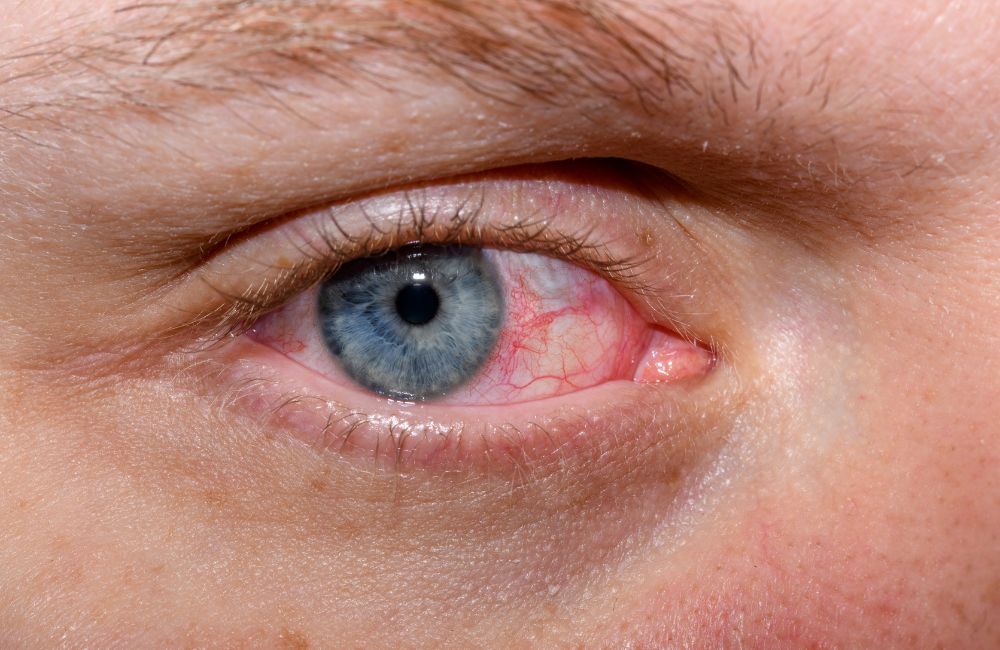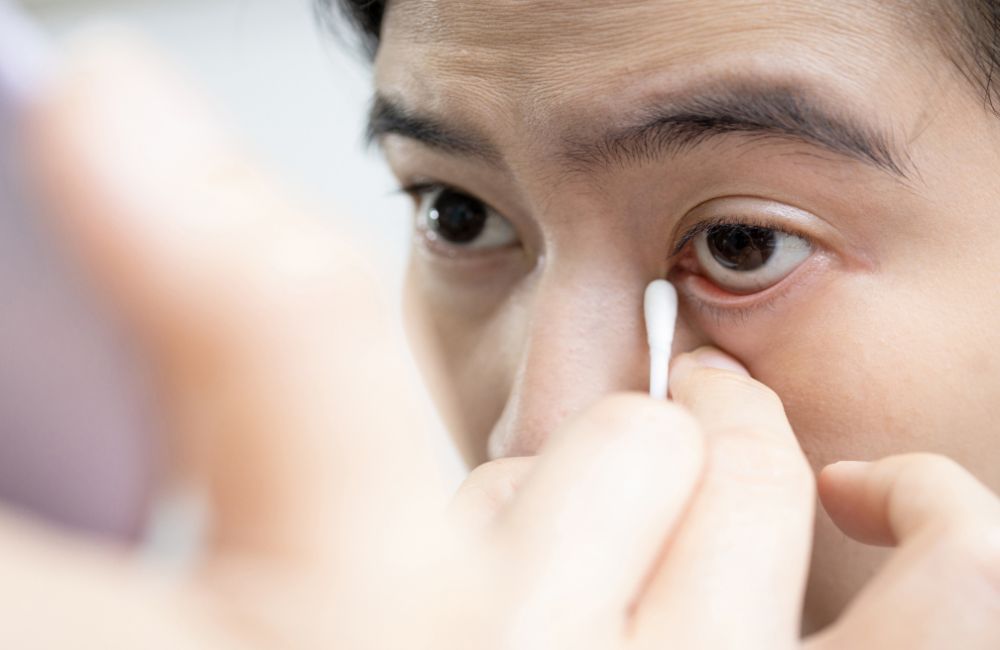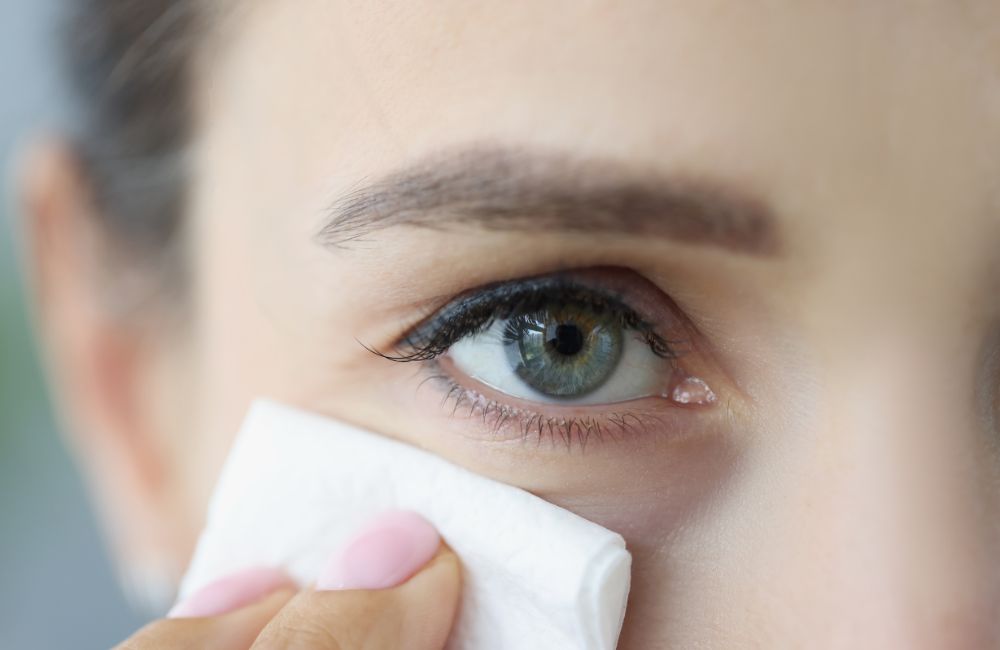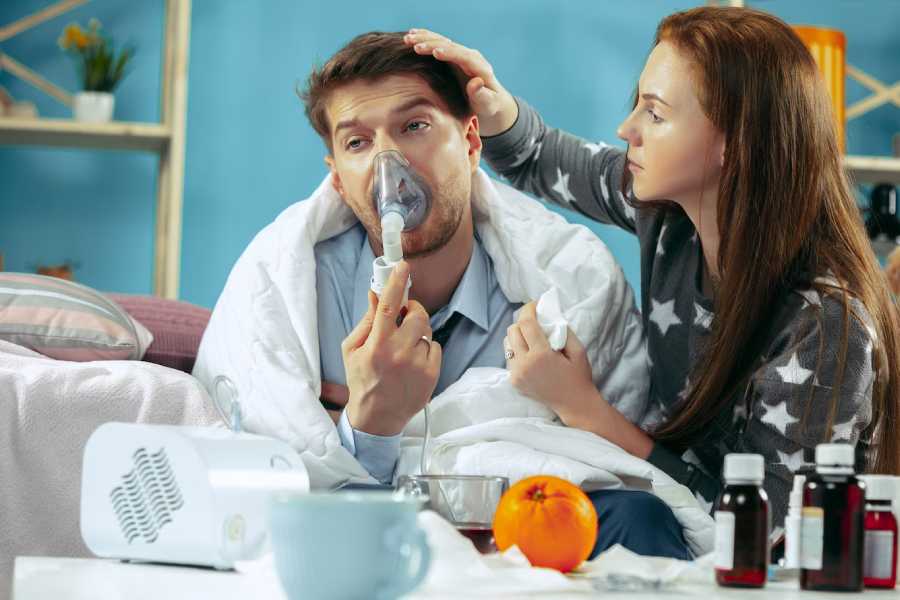
Watery eyes can significantly impact your daily life, signaling underlying health issues or environmental responses. Understanding these causes and knowing when to seek the expertise of a primary care doctor in Southington, CT, is key to finding relief and maintaining eye health.
Key Takeaways
1. Foreign Object in the Eye
2. Dry Eyes
3. Pinkeye (Conjunctivitis)
4. Allergies
5. Blocked Tear Duct
6. Eyelid Problems
7. Scratch on the Eye (Corneal Abrasion)
8. Styes
9. Eyelash Problems
10. Blepharitis
How to Diagnose Watery Eyes
Home Remedies for Watery Eyes
When to Call Your Primary Care Doctor in Southington, CT
FAQs
Protect Your Eye Health: Visit Docs Primary Care – Southington

When something like dust, sand, or even an eyelash gets into your eye, it can trigger reflex tearing to wash the object out. While this natural defense mechanism can often resolve the issue, there are times when a foreign object may cause more irritation or even a scratch on the cornea. If simple blinking or rinsing with clean water doesn’t alleviate the discomfort, it’s essential to avoid rubbing your eye and immediately seek assistance from a primary care doctor in Southington, CT. Docs Primary Care – Southington is well-equipped to handle such eye emergencies gently and effectively.
Counterintuitively, dry eye syndrome often leads to watery eyes as the body tries to compensate for the lack of moisture with excessive tear production. This condition can be exacerbated by factors like prolonged screen use, air conditioning, and heating — all common in modern living environments, including Southington, CT. Simple measures like artificial tears and regular screen breaks can help manage mild cases. However, if symptoms persist, consulting with a primary care doctor in Southington, CT, can provide more specific treatments such as prescription eye drops or lifestyle modifications.
Conjunctivitis, or pinkeye, is an inflammation of the conjunctiva, leading to redness, itchiness, and watering of the eyes. It can be caused by viral or bacterial infections, allergies, or irritant exposure. Given its contagious nature, especially in viral and bacterial forms, practicing good hygiene and seeking prompt medical advice is crucial. A reliable primary care doctor in Southington, CT, can offer effective treatments, including antibiotics for bacterial conjunctivitis and guidance on managing allergic forms.
Allergic reactions are a common cause of watery eyes, especially during high pollen seasons or due to indoor allergens like dust mites and pet dander. Over-the-counter antihistamines and avoiding known allergens can mitigate symptoms for many. Yet, for persistent or severe cases, a visit to a primary care doctor in Southington, CT may be necessary for allergy testing and more targeted treatments. They can advise on long-term management strategies, including prescription medications or immunotherapy.
A blocked tear duct prevents tears from draining normally, leading to watery, irritated eyes. This condition can affect individuals of all ages, from infants to adults. Symptoms include excessive tearing, recurrent eye infections, and blurred vision. Treatment often varies based on the cause of the blockage but may include tear duct massage, antibiotics for infection, or surgery in more severe cases. Consulting with a primary care doctor in Southington, CT, is crucial for accurate diagnosis and to discuss the best treatment options tailored to your needs.
Issues with the eyelids, such as blepharitis (inflammation of the eyelid edges), can also contribute to watery eyes. These conditions can cause irritation, red eyes, and a sensation of something being in the eye. Good eyelid hygiene, including regular cleaning and warm compresses, can help manage symptoms. However, persistent problems may require medical attention. Your primary care doctor in Southington, CT, can offer guidance on proper eyelid care or prescribe medication to treat any underlying infection or inflammation.
A scratch on the eye, or corneal abrasion, can occur from contact with dust, sand, or even contact lenses. Symptoms include pain, redness, sensitivity to light, and watery eyes. Minor abrasions often heal independently with proper care, such as avoiding rubbing the eye and using lubricating eye drops. Nevertheless, for larger scratches or if symptoms worsen, it’s vital to see a primary care doctor in Southington, CT, to prevent infection and ensure proper healing.
A stye is a painful, red bump on the edge of the eyelid caused by a bacterial infection of the eyelash follicles. While styes often resolve independently with home treatments like warm compresses, keeping the area clean, and avoiding makeup or contact lenses, severe or recurrent styes might require medical intervention. Your primary care doctor in Southington, CT, can prescribe antibiotics or perform a minor procedure to relieve the stye if necessary.
Lash problems, such as ingrown lashes (trichiasis), can irritate the eye and cause watering. Gentle eyelid cleaning and using warm compresses can help alleviate minor discomfort. However, a healthcare professional may need to remove the offending eyelash or lashes for persistent issues. Regular eye exams with a primary care doctor in Southington, CT, can help detect and address these problems before they lead to more serious complications.
Blepharitis is a chronic inflammation of the eyelids that leads to flaky skin, itching, and watery eyes. Managing blepharitis involves thorough eyelid cleaning, warm compresses, and possibly antibiotic or steroid eye drops for more severe cases. Ongoing care with a primary care doctor in Southington, CT, is essential for managing this condition effectively and avoiding long-term eye damage.

Diagnosing the root cause of watery eyes is essential for determining the most effective treatment plan. This process often begins with a comprehensive evaluation by your primary care doctor in Southington, CT, including a detailed history, physical examination, and possibly specific diagnostic tests.
A detailed medical history is the first step in diagnosing watery eyes. This involves discussing any existing health conditions, medications, allergies, and environmental exposures that could contribute to symptoms. Understanding the duration, frequency, and severity of the watery eyes and any associated symptoms (like redness, itching, or vision changes) helps narrow down the potential causes.
During the physical examination, your primary care doctor in Southington, CT, may inspect the eyes, eyelids, and surrounding skin for signs of irritation, infection, or blockage. They might also evaluate the tear ducts and glands for signs of dysfunction or obstruction, which could be contributing to excessive tear production or impaired drainage.
Several tests can aid in diagnosing the causes of watery eyes:
Home remedies can offer significant relief for watery eyes, especially when the condition is mild and caused by factors like allergies, minor irritations, or environmental conditions. Here are some effective strategies for managing and alleviating the symptoms of watery eyes at home.
Regularly washing your eyes with clean, lukewarm water can help remove irritants and allergens that may cause watering. For those with eyelid inflammation or blepharitis, applying a warm, damp cloth to the eyes for a few minutes can loosen debris and soothe the eyelids.
Dry air, particularly in winter or air-conditioned environments, can exacerbate eye dryness and subsequent watering. Using a humidifier in your home or workspace adds moisture to the air, helping to maintain eye hydration and comfort.
Cold compresses can provide immediate relief for eyes irritated by allergies or fatigue by reducing inflammation and soothing the delicate skin around the eyes. A clean, damp cloth chilled in the refrigerator for a few minutes is ideal.
Identifying and avoiding allergens is crucial for individuals whose watery eyes are triggered by allergic reactions. Keeping windows closed during high pollen seasons, using air purifiers, and avoiding exposure to pet dander and dust can significantly reduce symptoms.
Dehydration can contribute to dry eyes, leading to increased tear production. Ensuring you drink enough water throughout the day supports overall hydration, including the hydration of your eyes.
Antihistamine eye drops can be particularly effective for watery eyes caused by allergies. Artificial tears can also provide relief by lubricating the eyes and washing away irritants. However, it’s important to choose preservative-free options to avoid potential irritation.
Prolonged screen exposure can strain the eyes, leading to dryness and reflex tearing. Adopt the 20-20-20 rule: every 20 minutes, look away from your screen to focus on something 20 feet away for at least 20 seconds. This practice helps to reduce eye strain and maintain moisture levels in the eyes, preventing them from becoming watery. Regular breaks and ensuring your work environment is well-lit can also mitigate the effects of screen time on your eyes.
Wear sunglasses or protective eyewear outdoors to shield your eyes from wind, dust, and harmful UV rays. In windy, dusty, or sunny conditions, this can significantly reduce irritation that leads to watery eyes.
Knowing when to escalate your concerns about watery eyes to a healthcare professional is crucial for preventing complications and addressing any underlying health issues. While many instances of watery eyes can be managed with home remedies, certain situations require the expertise of a primary care doctor in Southington, CT. Here’s a guide to understanding when to make that call.
If your watery eyes persist beyond a week despite trying home remedies, it’s time to consult a trusted primary care doctor in Southington, CT, like those from Docs Primary Care – Southington. Persistent symptoms could indicate an underlying condition that requires medical intervention, such as an infection, chronic dry eyes, or a blocked tear duct.
Watery eyes accompanied by other symptoms can signal more serious issues. If you experience redness, light sensitivity, blurred vision, or pain, these could be signs of an eye infection, corneal abrasion, or other eye disorders that need prompt attention from a reputable primary care doctor in Southington, CT.
When watery eyes interfere with your daily activities, such as reading, driving, or using a computer, seeking professional advice is important. Your primary care doctor in Southington, CT, can assess your symptoms and provide treatments or referrals to specialists if necessary, ensuring your quality of life isn’t compromised.
Contact your primary care doctor in Southington, CT, immediately if you notice signs of infection, including yellow or green discharge, swelling around the eyes, or fever. Eye infections can quickly worsen and may require prescription medication to resolve.
For individuals who suspect allergies cause watery eyes, a consultation with your primary care doctor in Southington, CT, is warranted if there’s no improvement after using over-the-counter allergy medications. They can prescribe stronger medications or recommend allergy testing to identify specific triggers.
Patients with existing health conditions, such as diabetes or rheumatoid arthritis, should be cautious about watery eyes as they can indicate related complications. Regular check-ups with your primary care doctor in Southington, CT, can help manage these conditions and their ocular manifestations.
Watery eyes are not inherently contagious but can be a symptom of underlying conditions, such as viral or bacterial conjunctivitis, commonly known as pink eye. These infections can easily spread from person to person through direct contact with the affected individual’s tears, eye discharge, or objects they have touched. It’s important to observe good hygiene practices to prevent the spreading of any potential infection.
Differentiating between allergies and infections in children based on symptoms can be challenging. Allergic reactions cause watery, itchy eyes in both eyes simultaneously, often accompanied by sneezing or a runny nose, indicative of an allergic response. In contrast, infections may cause watery eyes alongside symptoms like pain, redness, a gritty feeling, or discharge that can be yellow or greenish, affecting one or both eyes. Consulting a primary care doctor in Southington, CT, is crucial for an accurate diagnosis and appropriate treatment.
The frequency of eye check-ups with a primary care doctor should ideally align with your overall health monitoring routine, typically annually. However, if you’re experiencing specific eye problems, have a condition that affects your eye health (like diabetes), or notice any changes in your vision, it’s advisable to schedule more frequent visits. Your primary care doctor in Southington, CT, can guide you based on your health status and risk factors, identifying and managing potential eye conditions promptly.
Diet plays a crucial role in overall eye health. A diet lacking essential vitamins and minerals, such as Vitamin A and omega-3 fatty acids, can lead to dry eyes and watery eyes as a compensatory mechanism. Incorporating a balanced diet with plenty of fruits, vegetables, and fish can support eye health and reduce symptoms.
Yes, wearing contact lenses can contribute to watery eyes, especially if the lenses are not properly cleaned, are worn for extended periods, or have an underlying dry eye condition. Contacts can interfere with the natural tear film, causing the eyes to become dry and irritated, which may trigger an overproduction of tears in an attempt to lubricate the eye and alleviate discomfort. It’s important to follow proper lens hygiene and wear protocols to minimize this risk.

Understanding the causes, symptoms, and remedies for watery eyes is essential for maintaining eye health. While home remedies can provide relief, recognizing when to seek professional help is crucial. For those in Southington, CT, experiencing persistent or severe symptoms, Docs Primary Care – Southington offers expert diagnosis and personalized treatment plans. Trust our experienced team to address your concerns and guide you toward the best solutions for your eye health, ensuring you receive the care and attention you deserve.



During this surge in COVID-19 cases, our primary focus is meeting the high demand for tests, and we are seeing higher than usual wait times. This means we are unable to answer most phone calls. Please know that our teams are working very hard during this time to care for as many patients as safely as possible. Please click the button below for answers to common questions. We appreciate your understanding.